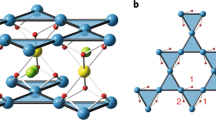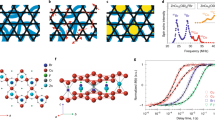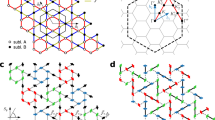Abstract
A three-dimensional system of interacting spins typically develops static long-range order when it is cooled. If the spins are quantum (S=1/2), however, novel quantum paramagnetic states may appear. The most highly sought state among them is the resonating-valence-bond state1,2, in which every pair of neighbouring quantum spins forms an entangled spin singlet (valence bonds) and these singlets are quantum mechanically resonating among themselves. Here we provide an experimental indication for such quantum paramagnetic states existing in frustrated antiferromagnets, ZnxCu4−x(OD)6Cl2, where the S=1/2 magnetic Cu2+ moments form layers of a two-dimensional kagome lattice. We find that in Cu4(OD)6Cl2, where distorted kagome planes are weakly coupled, a dispersionless excitation mode appears in the magnetic excitation spectrum below ∼20 K, whose characteristics resemble those of quantum spin singlets in a solid state, known as a valence-bond solid, that breaks translational symmetry. Doping with non-magnetic Zn2+ ions reduces the distortion of the kagome lattice, and weakens the interplane coupling but also dilutes the magnetic occupancy of the kagome lattice. The valence-bond-solid state is suppressed, and for ZnCu3(OD)6Cl2, where the kagome planes are undistorted and 90% occupied by the Cu2+ ions, the low-energy spin fluctuations become featureless.
This is a preview of subscription content, access via your institution
Access options
Subscribe to this journal
Receive 12 print issues and online access
$259.00 per year
only $21.58 per issue
Buy this article
- Purchase on Springer Link
- Instant access to full article PDF
Prices may be subject to local taxes which are calculated during checkout





Similar content being viewed by others
References
Anderson, P. W. Resonating valence bonds—new kind of insulator. Mater. Res. Bull. 8, 153–160 (1973).
Fazekas, P. & Anderson, P. W. Ground-state properties of anisotropic triangular antiferromagnet. Phil. Mag. 30, 423–440 (1974).
Anderson, P. W. The resonating valence bond state in La2CuO4 and superconductivity. Science 235, 1196–1198 (1987).
Kivelson, S. A., Rokhsar, D. S. & Sethna, J. P. Topology of the resonating valence-bond state—solitons and high-Tc superconductivity. Phys. Rev. B 35, 8865–8868 (1987).
Read, N. & Sachdev, S. Large-N expansion for frustrated quantum antiferromagnets. Phys. Rev. Lett. 66, 1773–1776 (1991).
Hastings, M. B. Dirac structure, RVB, and Goldstone modes in the kagomé antiferromagnet. Phys. Rev. B 63, 014413 (2001).
Park, K. & Sachdev, S. Bond and Néel order and fractionalization in ground states of easy-plane antiferromagnets in two dimensions. Phys. Rev. B 65, 220405(R) (2002).
Senthil, T., Balents, L., Sachdev, S., Vishwanath, A. & Fisher, M. P. A. Quantum criticality beyond the Landau–Ginzburg–Wilson paradigm. Phys. Rev. B 70, 144407 (2004).
Ran, Y., Hermele, M., Lee, P. A. & Wen, X.-G. Projected wavefunction study of spin-1/2 Heisenberg model on the kagomé lattice. Phys. Rev. Lett. 98, 117205 (2007).
Ryu, S., Motrunich, O. I., Alicea, J. & Fisher, M. P. A. Algebraic vortex liquid theory of a quantum antiferromagnet on the kagomé lattice. Phys. Rev. B 75, 184406 (2007).
Ramirez, A. P. in Handbook on Magnetic Materials Vol. 13 (ed. Busch, K. J. H.) 423 (Elsevier Science, Amsterdam, 2001).
Lee, S.-H. et al. Emergent excitations in a geometrically frustrated magnet. Nature 418, 856–858 (2002).
Shores, M. P. et al. A structurally perfect S=1/2 kagomé antiferromagnet. J. Am. Chem. Soc. 127, 13462–13463 (2005).
Helton, J. S. et al. Spin dynamics of the spin-1/2 kagomé lattice antiferromagnet ZnCu3(OH)6Cl2 . Phys. Rev. Lett. 98, 107204 (2007).
Ofer, O. et al. Ground state and excitation properties of the quantum kagomé system ZnCu3(OH)6Cl2 investigated by local probes. Preprint at <http://www.arxiv.org/cond-mat/0610540> (2006).
Mendels, P. et al. Quantum magnetism in paratacamite family: Heading towards an ideal kagomé lattice. Phys. Rev. Lett. 98, 077204 (2007).
Zheng, X. G. et al. Unconventional magnetic transitions in the mineral clinoatacamite Cu2Cl(OH)3 . Phys. Rev. B 71, 052409 (2005).
Zheng, X. G. et al. Coexistence of long-range order and spin fluctuation in geometrically frustrated clinoatacamite Cu2Cl(OH)3 . Phys. Rev. Lett. 95, 057201 (2005).
Sato, T. J. et al. Unconventional spin fluctuations in the hexagonal antiferromagnet YMnO3 . Phys. Rev. B 68, 014432 (2003).
Nishiyama, M. et al. Magnetic ordering and spin dynamics in potassium jarosite: A Heisenberg kagome lattice antiferromagnet. Phys. Rev. B 67, 224435 (2003).
Matan, M. et al. Spin waves in the frustrated kagome lattice antiferromanget KFe3(OH)6(SO4)2 . Phys. Rev. Lett. 96, 247201 (2006).
Furrer, A. & Gudel, H. U. Neutron inelastic-scattering from isolated clusters of magnetic ions. J. Magn. Magn. Mater. 14, 256–264 (1979).
Lee, S.-H. et al. Isolated spin pairs and two-dimensional magnetism in SrCr9pGa12−9pO19 . Phys. Rev. Lett. 76, 4424–4427 (1996).
Rigol, M. & Singh, R. R. P. Magnetic susceptibility of the kagomé antiferromagnet. Phys. Rev. Lett. 98, 207204 (2007).
Levi, B. G. New candidate emerges for a quantum spin liquid. Phys. Today 60, 16–19 (2007).
Mizuno, Y. et al. Electronic states and magnetic properties of edge-sharing Cu–O chains. Phys. Rev. B 57, 5326–5335 (1998).
Tornow, S., Entin-Wohlman, O. & Aharony, A. Anisotropic superexchange for nearest and next-nearest coppers in chain, ladder, and lamellar cuprates. Phys. Rev. B 60, 10206–10215 (1999).
Acknowledgements
We thank D. Khomskii, S. Sachdev and M. Gingras for helpful discussions. S.-H.L. is supported by US DOC through NIST-70NANB5H1152. Activities at NIST were partially supported by NSF through DMR-0454672.
Author information
Authors and Affiliations
Corresponding author
Ethics declarations
Competing interests
The authors declare no competing financial interests.
Supplementary information
Supplementary Information
Supplementary figures S1-S5 and tables S1-S4 (PDF 9685 kb)
Rights and permissions
About this article
Cite this article
Lee, SH., Kikuchi, H., Qiu, Y. et al. Quantum-spin-liquid states in the two-dimensional kagome antiferromagnets ZnxCu4−x(OD)6Cl2. Nature Mater 6, 853–857 (2007). https://doi.org/10.1038/nmat1986
Received:
Accepted:
Published:
Issue Date:
DOI: https://doi.org/10.1038/nmat1986
This article is cited by
-
Possible chiral spin liquid state in the S = 1/2 kagome Heisenberg model
npj Quantum Materials (2024)
-
Record-high mobility and extreme magnetoresistance on kagome-lattice in compensated semimetal Ni3In2S2
Science China Materials (2023)
-
Magnetization plateaus and thermodynamic properties of a ferrimagnetic Kagome-like nanoparticle under an applied magnetic field
Journal of Materials Science (2022)
-
Magnetoelectric multiferroicity and quantum paraelectricity in hexaferrites
Science China Physics, Mechanics & Astronomy (2019)
-
Spin-liquid-like state in a spin-1/2 square-lattice antiferromagnet perovskite induced by d10–d0 cation mixing
Nature Communications (2018)



